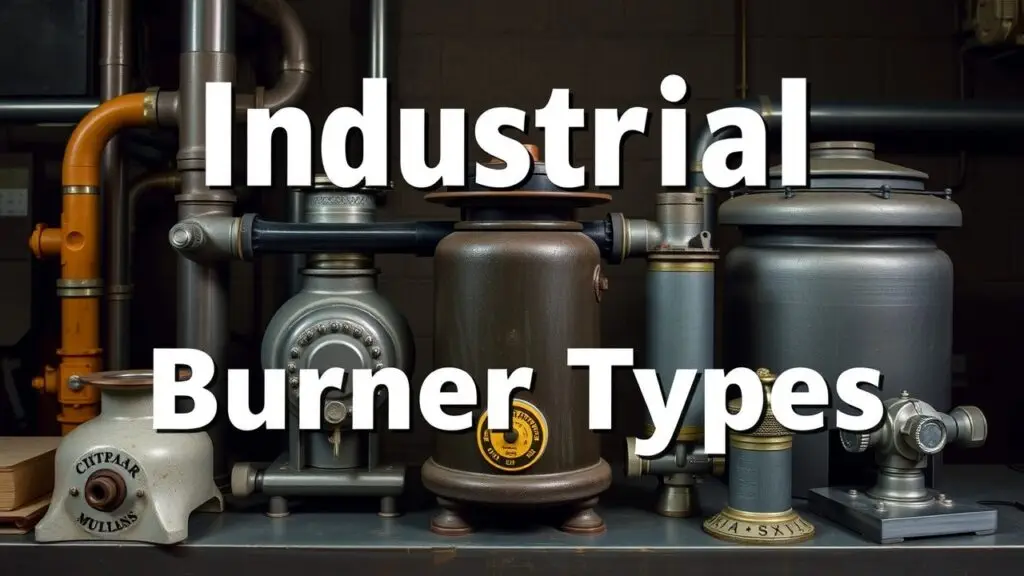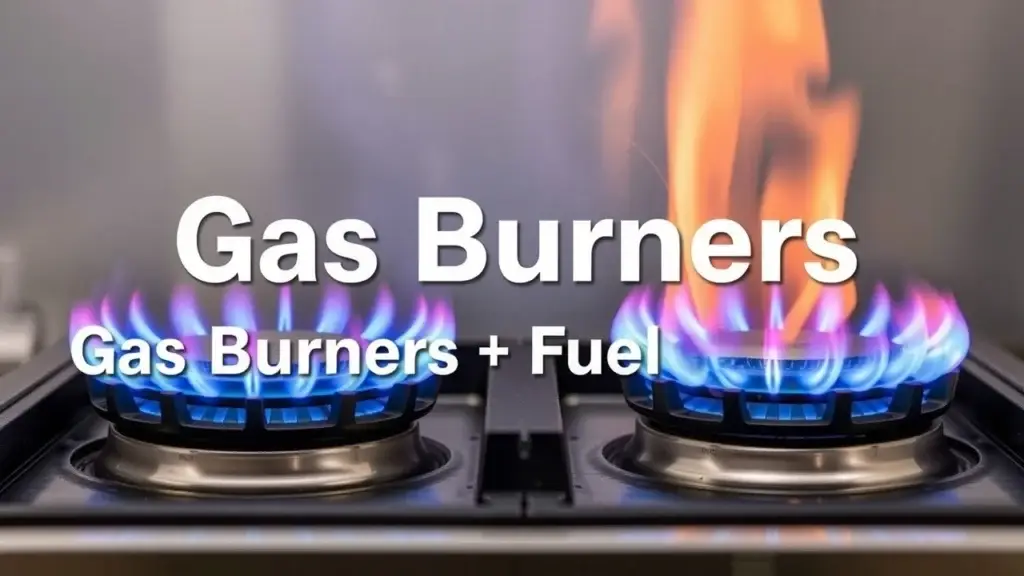Types of industrial burners vary widely by fuel (gas, oil, dual-fuel) and application. This guide helps you choose the best burner for efficiency and performance.
What Are Industrial Burners?

Industrial burners are key parts of process heating systems. They generate heat by burning fuels like natural gas or oil. Their main job is to provide controlled and efficient thermal energy for many industrial uses. These devices are important in various sectors, such as manufacturing, power generation, food processing, and metallurgy. They ensure that high-temperature processes happen safely and effectively.
In simple terms, industrial burners turn fuel into heat energy while performing well. There are different types of burners for specific needs: gas burners use gaseous fuels; oil burners work with liquid fuels; and custom burners can be built for special requirements. Each type plays a unique role in industrial heating systems and boosts operational efficiency.
Why Understanding Burner Types Matters?
Choosing the right burner type is key to getting the best efficiency and following emissions rules. The right burner affects not just costs but also safety at work. For example, low NOx (nitrogen oxides) burners help meet tough environmental standards while lowering harmful emissions.
If you pick the wrong industrial burner, you might waste fuel or face issues with rules that could lead to fines or halts in operations. That’s why knowing about different burner types, their efficiency, and what fuel types they use is super important for those buying them and managers in plants.
When looking at options for burner selection, think about:
- Efficiency: How well does the burner change fuel into usable heat?
- Emissions Compliance: Does it follow local environmental laws?
- Fuel Type Compatibility: Is it good for natural gas, oil, or dual-fuel use?
By looking closely at these factors when choosing a burner, industries can improve their heating solutions and cut costs tied to inefficiencies or rule-breaking.
Classification of Industrial Burners by Fuel Type
Gas Burners Explained
Gas burners play a key role in many industrial settings. They are popular for their clean combustion and easy availability. These burners can be used in furnaces, boilers, and kilns. This helps industries meet their heating needs effectively. The main types of gas burners include natural gas burners and propane burners.
Natural gas burners often provide higher efficiency. They also have lower emissions than other fuel types. These burners use methane, which burns cleaner than oil or coal. Propane burners are useful in areas where natural gas is not available. While propane can produce slightly more emissions than natural gas, it is still a solid choice for industrial heating systems.
Knowing the specific features of each type helps industries optimize their operations. This can lead to reduced costs and less maintenance because there are fewer moving parts involved.
Propane vs Natural Gas Burners: Key Differences
When looking at propane pipe burners and natural gas burners, several important factors come into play:
- Efficiency Levels: Natural gas generally offers better thermal efficiency because it has more energy per unit.
- Cost-Effectiveness: Prices can change quickly for both fuels. Local market conditions will affect which fuel is cheaper.
- Application Suitability: Some uses may favor one fuel over the other based on supply or performance needs—natural gas works well for ongoing operations due to its reliable supply.
Understanding these differences helps businesses choose the right burner type that fits their needs and budgets.
Oil-Fired Burners Overview
Oil-fired burners are known for their high heat output, which is essential in many industrial processes. However, they do face challenges with emissions control that regulatory bodies impose. These systems mainly use either heavy oil or light oil as fuel sources.
Heavy oil burners are efficient at generating high amounts of heat but need advanced emission control technology due to the higher sulfur content, which can produce harmful pollutants if not managed correctly. Light oil, like diesel, is easier to handle and burns cleaner but can increase operational costs depending on current prices for crude versus refined oils.
Choosing between heavy oil and light oil depends on factors like required temperatures during processing cycles and compliance with air quality regulations in various regions.
Heavy Oil vs Light Oil Burner Comparison
There are clear differences between heavy oil and light oil burner systems:
- Efficiency Levels: Heavy oil systems can achieve greater thermal efficiency under ideal conditions but need careful maintenance.
- Maintenance Needs: Light oil units are usually easier to maintain due to simpler designs and fewer issues with residue buildup.
This comparison can help industries decide which type best meets their production needs while balancing cost and environmental responsibilities.
Dual-Fuel Burners for Versatility
Dual-fuel systems offer great flexibility by allowing operators to switch fuels based on what’s available or what’s cheaper without sacrificing performance in various sectors. This includes manufacturing plants that require dependable energy throughout different phases of operation, reducing downtime risks associated with relying on a single fuel source.
These setups make it easy to switch between fuels quickly, ensuring continuous operation even when supply chain issues arise. This approach enhances resilience against unexpected challenges while supporting long-term business growth strategies.
Classification Based on Combustion Methodology
Premix vs Diffusion Mix Burning Systems Explained
Industrial burners come in two main types: premix burners and diffusion burners. Each type has its own way of mixing air and fuel, which affects efficiency and emissions.
Premix Burners mix air and fuel before ignition. This method creates a uniform mixture, leading to better combustion efficiency. A big benefit of using premix burners is that they produce low nitrogen oxide (NOx) emissions. The controlled mixing helps burn at lower temperatures, making these burners a great choice where environmental rules are strict or energy efficiency is key.
In contrast, Diffusion Burners mix air and fuel during the combustion process. Their design is usually simpler, but this can lead to higher NOx emissions. The mixing occurs when temperatures are high, which isn’t as friendly for the environment. While diffusion burners might not control emissions as well as premix types, they are easier to maintain and can work with different fuel qualities.
Key Differences
- Mixing Process
- Premix Burners: Air and fuel mixed before ignition.
- Diffusion Burners: Air and fuel mixed during combustion.
- Emissions
- Premix Burners: Low NOx emissions.
- Diffusion Burners: Higher potential NOx emissions.
- Efficiency
- Premix Burners: High efficiency.
- Diffusion Burners: Moderate efficiency.
- Complexity
- Premix Burners: More complex design.
- Diffusion Burners: Simpler design.
- Maintenance Requirements
- Premix Burners: May need specialized maintenance.
- Diffusion Burners: Generally easier to maintain.
Both burner types have their own pros and cons based on what you need—like how strict your emission rules are or how simple you want the operation to be. When picking an industrial burner, think about these factors to help ensure you choose the right one for your needs.
Gas Burners: Fuel Types and Applications
Natural Gas Burners
Natural gas burners are commonly used in many industries. They work with natural gas, mainly made of methane. This type of gas provides clean combustion and helps meet emissions regulations. Using natural gas also means lower fuel consumption and better energy efficiency. However, in some areas, finding natural gas can be tough.
When choosing an industrial gas burner, think about the application requirements, local emissions laws, and overall costs. Keeping up with maintenance is important for performance and staying within environmental rules.
Propane Burners
Propane burners are another popular option in different industrial settings. They use propane, which comes from processing natural gas. Propane has many benefits over other fuels. One big plus is that it’s portable. You can store propane in tanks or cylinders, making it handy for places without pipelines.
Propane burns cleanly with little soot and low NOx emissions if it’s set up right. This makes propane a good choice for industries wanting to lessen their environmental impact while keeping high performance.
Other Gas Fuels
Besides natural gas and propane, there are other fuels that are becoming more popular:
- Biogas Burners: These use organic waste to make biogas through anaerobic digestion.
- Coke Oven Gas Burners: Used mainly in steel plants where coke oven gases are made during coal carbonization.
- Hydrogen Burners: Hydrogen is a new option that could help reduce carbon footprints because it only produces water vapor when burned.
These fuels offer different chances but need careful planning to work with current systems.
High-Pressure vs. Low-Pressure Gas Burners
The differences between high-pressure and low-pressure gas burners affect how suitable they are for various jobs:
| Feature | High-Pressure Gas Burner | Low-Pressure Gas Burner |
|---|---|---|
| Operating Pressure | Usually above 5 psi | Typically below 5 psi |
| Applications | Industrial heating that needs quick heat | Residential heating or smaller tasks |
| Control Systems | More complex control needed | Simpler controls |
High-pressure burners react quickly but come with safety risks due to higher pressure. Low-pressure systems are simpler and easier to maintain but might not perform as well under tough conditions.
Knowing these differences helps people pick the right burner type for their needs while keeping safety in mind.
Oil Burners: Fuel Types, Efficiency, and Maintenance
Heavy Oil Burners
Heavy oil burners are made for thick fuels like bunker fuel or heavy diesel. These industrial oil burners work at higher temperatures and pressures than lighter oil burners. The benefits of heavy oil burners include burning cheap fuels efficiently and being perfect for big operations.
But there are some issues. Heavy oils need to be heated up for good atomization, which can use more energy at startup. If not managed well, they can also produce higher emissions. So, burner efficiency is key to cutting costs while meeting environmental rules.
Key Features of Heavy Oil Burners:
- Fuel Types: Mainly use heavy oils like bunker fuel.
- Efficiency Considerations: Need good heat exchange systems for best results.
- Applications: Commonly found in power plants and large factories.
Lighter Oil Burners
Lighter oil burners use fuels like kerosene or light diesel. They are famous for high efficiency and cleaner burning compared to heavier types. These industrial fuel burners are often used where quick startups and lower emissions matter most.
The main advantage of lighter oil burners is how fast they reach stable flame conditions due to the lower thickness of the fuel. This helps with burner applications in industries such as food processing, textiles, and pharmaceuticals.
Key Characteristics of Light Oil Burners:
- Fuel Applications: Work well with many light hydrocarbons.
- High-Efficiency Options: Many come with advanced tech that boosts thermal efficiency.
- Environmental Impact: Usually produce less pollution than heavy oil types.
Atomization Methods
Atomization methods are crucial for how well an industrial burner works. They break down liquid fuel into tiny droplets before combustion happens. Two common types are pressure atomizing and air atomizing:
- Pressure Atomizing: High pressure pushes liquid through a nozzle, making fine particles ideal for efficient burning.
- Air Atomizing: This method uses compressed air with liquid fuel, creating smaller droplets that mix better with air for improved combustion quality.
Both methods affect burner efficiency improvement; however, pressure atomizers usually create more uniform droplet sizes, leading to better combustion stability across different load conditions.
Impact on Efficiency and Emissions
Combustion efficiency impacts both operational costs and environmental effects when using various types of industrial burners. Low NOx (Nitrogen Oxides) burners aim to cut harmful emissions while still performing well.
By improving airflow patterns inside the combustor chamber and managing temperature profiles during operation, these modern designs meet strict regulations while keeping high thermal efficiencies in many settings.
Oil Burner Maintenance and Troubleshooting
Regular maintenance is important to keep any industrial burner system running smoothly—whether it’s an industrial gas or oil burner setup—and includes several key practices:
- Establish an Industrial Burner Maintenance Schedule:
- Perform routine inspections according to manufacturer guidelines, focusing on parts like nozzles, filters, and pumps.
- Use Professional Burner Repair Services:
- Hiring certified technicians makes sure safety protocols are followed and helps solve complex issues quickly to minimize downtime.
- Follow a Burner Troubleshooting Guide:
- Knowing common problems like uneven flame patterns or strange noises helps operators spot issues early on, preventing costly repairs later.
- Plan for Burner Parts Replacement:
- Keeping an inventory of spare parts ensures timely replacements and keeps system uptime high throughout operations.
Understanding the different types of industrial burners—along with their fuel sources, effectiveness, and upkeep—is key for boosting performance while reducing environmental impact in any industry setting.
Dual-Fuel Burners: Flexibility and Operational Considerations
Advantages of Dual-Fuel Systems
Dual-fuel burners have many benefits. They let users switch between fuels based on what’s cheaper or more available. This is really helpful for businesses facing changing fuel prices or supply issues. For instance, if a factory can use either natural gas or oil, it can save money and keep producing without stopping.
These systems also help reduce downtime when fuel is hard to find. If one fuel type runs out because of market problems, switching to another fuel means operations can keep going. This flexibility improves energy efficiency and ensures that industrial burner applications stay on track.
Disadvantages of Dual-Fuel Systems
Even though dual-fuel systems offer flexibility, they have some downsides. One big issue is the extra complexity. Setting up a dual-fuel system costs more than just using one fuel since you need additional parts and technology.
Also, maintaining these systems can be more complicated. The equipment requires advanced controls and monitoring to work well with both fuels. This means staff need specialized training for industrial burner maintenance and operation, which could increase costs over time.
Fuel Switching Mechanisms and Prioritization Strategies
Fuel switching mechanisms are essential for smooth operation in dual-fuel burners. Common methods include using automated burner controls that check real-time data on fuel prices and availability.
Prioritization strategies are also necessary. Operators should know when to favor one fuel over another depending on costs or environmental rules. By using effective control systems, plants can quickly adjust their operations while being smart about market conditions.
Applications Best Suited for Dual-Fuel Burners
Dual-fuel burners are widely used in industries where flexibility is key. For example, manufacturing plants that need steady heat output find this technology very useful, especially when market conditions change often.
Some examples include chemical processing facilities that switch from natural gas burners during high-demand times to propane burners when prices drop unexpectedly. This ability allows companies to stay productive and adapt quickly without losing sight of safety standards in modern industrial burner designs.
Low NOx Burners
Low NOx burners are made to lower nitrogen oxide (NOx) emissions during burning. They use advanced methods like staged combustion and lean premix techniques to control how fuel burns. By fine-tuning the air-fuel mix and when the fuel is added, these burners help create cleaner combustion while keeping high efficiency. This is key for industries that must follow strict emissions rules.
Benefits of Low NOx Burners:
- Better Air Quality: Less nitrogen oxides means cleaner air.
- Reduced Environmental Impact: Good for the planet!
- Regulatory Compliance: Helps companies meet emissions laws.
Regenerative Burner
Regenerative burners work by capturing waste heat from flue gases. This heat preheats incoming air or fuel before it enters the burner. It improves energy efficiency, which cuts down on fuel use.
These burners shine in high-temperature tasks, like glass making or metal processing. By recycling energy, regenerative burners help save money and reduce waste.
Uses of Regenerative Burners:
- Glass Manufacturing: Great for high heat and energy savings.
- Metal Processing: Keeps heating consistent without wasting fuel.
Oxy-Fuel Burners
Oxy-fuel burners burn using pure oxygen or enriched air instead of regular air. This change means hotter flames and better thermal efficiency than standard systems. Industries like welding and cutting benefit a lot because they need strong flames for detailed work.
Safety is key when using oxy-fuel systems since handling pure oxygen can be risky.
Advantages of Oxy-Fuel Systems:
- Higher Thermal Efficiency: Better temperature control.
- Cleaner Combustion Process: Cuts down on pollution during use.
Other Specialized Burners
Different specialized burners meet specific industrial needs:
- Self-Recuperative Burners – These use exhaust heat to warm up intake gas, boosting overall system efficiency.
- Cold Air Burners – Made for processes needing lower temperature flames without losing performance; useful in drying applications where too much heat can ruin products.
- Hot Air Burners – Use heated air before ignition; this method enhances energy use in drying processes across various industries.
Choosing the right burner type helps companies improve productivity while staying within emission standards.
Industrial Burner Selection: A Step-by-Step Guide

Choosing the right industrial burner is key to making your heating process more effective. Here’s a simple guide to help you pick the best burner for your needs.
Determining Heat Requirements (BTU/kW Calculations)
To figure out how much heat your process needs, you’ll need to calculate the required British Thermal Units (BTUs) or kilowatts (kW). This usually means looking at how much material you want to heat, what temperature you want to reach, and how fast you need to do it. For example, if you want to raise the temperature of a certain amount of water by a specific degree within an hour, you can use that info to determine the BTUs or kW your burner should provide.
Fuel Type Selection
Picking the right fuel type matters for efficiency and costs. Common fuels include natural gas, propane, diesel oil, and biofuels. Check what’s available in your area and how much it costs. You also need to think about emissions regulations since some areas have stricter rules on pollutants than others.
Combustion Efficiency and Optimization Strategies
Improving combustion efficiency can save money and boost performance. Here are some tips:
- Regularly tune your burners to keep air-to-fuel ratios just right.
- Follow maintenance schedules closely.
- Use advanced control systems for real-time monitoring.
Burner Size and Capacity
It’s super important to match the burner’s size with your heating needs. Don’t just look at maximum output; consider turndown ratios too. This ratio shows how well a burner can reduce output without losing efficiency when demand is low. Choosing a properly sized unit ensures steady operation even when load changes.
Industrial Burner Operation, Maintenance, and Safety
Running an industrial burner safely requires following safety rules and performing regular maintenance checks.
Proper Installation Procedures
Installation should always be done by trained professionals who understand the manufacturer’s specs as well as local safety codes. A bad installation can lead to leaks or other serious risks that could harm workers.
Safety Precautions and Personal Protective Equipment (PPE)
Good safety practices protect everyone during daily operations in high-temperature environments. Here’s a quick list of essential safety measures along with recommended PPE:
- Flame Monitoring: Fire-resistant gloves
- Gas Leak Detection: Safety goggles
- Emergency Shut-off Procedures: Hard hats
Fuel Efficiency Tips
To save on fuel costs:
- Keep burners clean to avoid soot build-up.
- Adjust airflow settings regularly.
- Check insulation around piping systems to prevent energy loss.
Troubleshooting Common Burner Issues
Operators often face issues like unstable flames or changing pressure readings that might hint at blockages. Quick action is needed here! Identify these problems early to maintain productivity.
FAQs About Types of Industrial Burners
What are the different types of industrial burners?
Industrial burners can be categorized into gas burners, oil burners, and dual-fuel burners. Each type has unique features suited for specific applications.
How do I choose the right industrial burner?
Consider factors like heat requirements, fuel availability, efficiency, and emissions regulations. Assess your specific application needs to select the best burner.
What are low NOx burners?
Low NOx burners minimize nitrogen oxide emissions. They use advanced combustion techniques to comply with environmental regulations.
What is the importance of burner maintenance?
Regular maintenance ensures optimal performance, safety, and compliance with regulations. Scheduled inspections can prevent costly downtime and repairs.
How does burner design impact efficiency?
Burner design influences airflow patterns and combustion quality. Efficient designs optimize fuel use while reducing emissions.
Additional Information on Industrial Burners
Types of Industrial Burner Applications
- Stainless Steel Pipe Burners: Ideal for high-temperature processes.
- Radial Ring Burners: Provide uniform heat distribution.
- Torch Burners: Used in welding and metal cutting tasks.
- Oxy-Fuel Burners: Enhance combustion efficiency in heating and cutting.
- Dual-Fuel Systems: Offer flexibility in fuel choice based on market conditions.
Understanding Industrial Burner Components
- Combustion Chamber: The area where fuel combustion occurs.
- Flame Sensing Equipment: Monitors flame presence for safety.
- Ignition Transformer: Initiates the ignition process for burner operation.
- Safety Shut-Off Valves: Prevent fuel leaks during emergencies.
Industrial Burner Safety Measures
- Follow local safety regulations.
- Use appropriate PPE during operation.
- Conduct regular safety inspections on equipment.
Advancements in Burner Technology
- Automated Burner Controls: Improve precision in fuel-air mixtures.
- Energy-Efficient Burners: Reduce operational costs while minimizing environmental impact.
- Regenerative Burners: Capture waste heat to improve overall system efficiency.
Related Topics
- Types of Gas Burners
- Types of Oil Burners
- Types of Atomization Methods
- Types of Combustion Systems (Premix vs. Diffusion)
- Types of Dual-Fuel Burners
- Types of Low NOx Burners
- Types of Regenerative Burners
- Types of Oxy-Fuel Burners
- Types of Specialized Burners
- Types of Industrial Burner Applications
- Types of Industrial Burner Components
- Types of Industrial Burner Safety Measures
- Types of Fuel for Industrial Burners



Types of Industrial Burners: A Guide to Fuel Types, Efficiency, and Applications